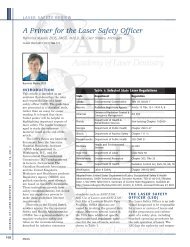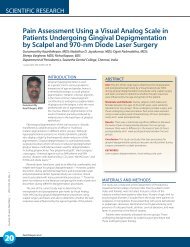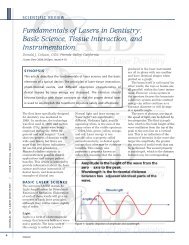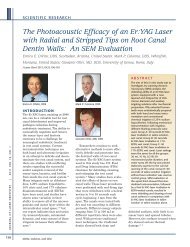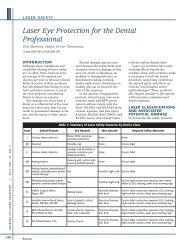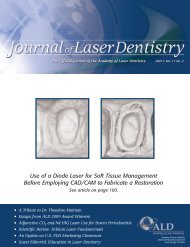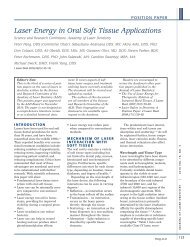You also want an ePaper? Increase the reach of your titles
YUMPU automatically turns print PDFs into web optimized ePapers that Google loves.
prevent the sores will have considerable<br />
clinical importance.<br />
Consultation with the oncologist<br />
should always be done prior to<br />
commencing laser treatments.<br />
Fractures and Orthognathic Surgery<br />
PBM accelerates healing <strong>of</strong> bone<br />
after fractures or orthognathic<br />
surgery through the stimulation <strong>of</strong><br />
osteoblasts. A 2005 study in rats<br />
demonstrated that laser irradiation<br />
resulted in an increase in bone<br />
ne<strong>of</strong>ormation, with better quality<br />
bone on the irradiated groups when<br />
compared to the control group, who<br />
received no radiation. 11<br />
S<strong>of</strong>t Tissue Lesions<br />
S<strong>of</strong>t tissue lesions, such as herpes<br />
simplex, denture sores, and angular<br />
cheilitis respond positively to lowlevel<br />
laser irradiation. Schindl and<br />
Neumann investigated the effect <strong>of</strong><br />
LLLT on recurrent herpes simplex<br />
and demonstrated that 10 daily<br />
irradiations significantly lowered<br />
the incidence <strong>of</strong> local recurrence<br />
and is a beneficial treatment alternative<br />
to commonly used drugs<br />
such as acyclovir and famciclovir. 17<br />
Further, the author has clinically<br />
observed that laser irradiation <strong>of</strong><br />
herpes simplex decreases the incidence<br />
<strong>of</strong> lesion recurrence. Marei et<br />
al. examined the effect <strong>of</strong> laser<br />
irradiation on denture sores and<br />
noted that LLLT eased the pain<br />
caused by denture lesions, while at<br />
4 weeks post-treatment the laserirradiated<br />
areas showed clinically<br />
superior healing, and histological<br />
epithelialization and vascularization<br />
<strong>of</strong> the lesion. 18 Tunér and Hode<br />
report successful treatment <strong>of</strong><br />
angular chelitis with PBM, but<br />
warn <strong>of</strong> its recurrence if the fundamental<br />
cause is not dealt with. 19 It<br />
is advantageous to treat any s<strong>of</strong>t<br />
tissue lesion in its most acute<br />
stage. For example, herpetic lesions<br />
are most susceptible to LLLT<br />
during their prodromal stage.<br />
Figure 4 demonstrates the treatment<br />
<strong>of</strong> a lesion on the lip using an<br />
830-nm PBM device.<br />
C L I N I C A L R E V I E W A N D C A S E R E P O R T S<br />
Dental Infections<br />
For infections and edema, PBM has<br />
been reported to dilate lymphatic<br />
vessels and reduce the permeability<br />
<strong>of</strong> blood vessels. 20 Figure 5 demonstrates<br />
the application to the<br />
lymph nodes using a PBM device.<br />
Primary Tooth Restorations<br />
A variety <strong>of</strong> factors contribute to<br />
the analgesic effect produced by<br />
PBM which allows dental practitioners<br />
to perform many primary<br />
tooth restorations without anesthesia.<br />
Small animal studies show<br />
that laser irradiation promotes a<br />
release <strong>of</strong> endorphins and serotonin;<br />
inhibits the conduction <strong>of</strong><br />
C fibers, the fibers that carry<br />
pulpal pain; and increases oxygenation<br />
and lymphatic drainage, which<br />
are responsible for pain relief after<br />
the first minutes <strong>of</strong> tissue irradia-<br />
6, 21-22 tion.<br />
Figure 4: LLLT treatment <strong>of</strong> a s<strong>of</strong>t tissue<br />
lesion<br />
C A S E S T U DY : D RY S O C K E T<br />
Treating Dentist: Dr. Gerald Ross<br />
A 45-year-old male patient had a lower first molar extracted.<br />
During the postoperative instructions, the patient (a smoker) was<br />
advised to avoid smoking cigarettes for a minimum <strong>of</strong> 2 days. The<br />
patient presented the following day with dry socket and admitted to<br />
smoking the previous evening.<br />
An 830-nm PBM device was used. The intraoral light guide was<br />
placed in the socket and the socket was irradiated until pain relief<br />
was felt by patient (in this case 48 J/cm 2 <strong>of</strong> energy was applied before<br />
the patient started to experience a reduction in discomfort). A<br />
dressing was placed into the socket and the patient was sent home<br />
without any pain medications. The patient returned the next day for<br />
a dressing change and the laser was applied into the socket using 4<br />
J/cm 2 before application <strong>of</strong> the new dressing for stimulation <strong>of</strong> the<br />
epithelium in the socket. The patient did not require any additional<br />
treatments and the area healed in 7 days.<br />
C A S E S T U DY : O R A L M U C O S I T I S<br />
Treating Dentist: Dr. Gerald Ross<br />
A 61-year-old female patient undergoing chemotherapy for terminal<br />
cancer presented with numerous sores over the inside <strong>of</strong> her mouth.<br />
The patient could not eat, drink, or swallow without extreme pain.<br />
Treatments (mouth rinses) assigned by the oncologist had no effect<br />
on healing <strong>of</strong> the sores. A visible red laser (660 nm) was applied<br />
intraorally overlapping throughout the mouth for 2 days in a row.<br />
When the patient came in on the second day, the pain was markedly<br />
decreased and she was able to eat soup. By the fourth day, she was<br />
able to eat normally. The patient passed away in the following month<br />
but no sores returned during that time.<br />
NOTE: Prior to laser treatment, the dentist contacted the oncologist<br />
who was willing to try any treatment that could work on the<br />
mucositis.<br />
Ross and Ross<br />
J O U R N A L O F L A S E R D E N T I S T R Y | 2 011 V O L . 19 , N O . 3<br />
291





